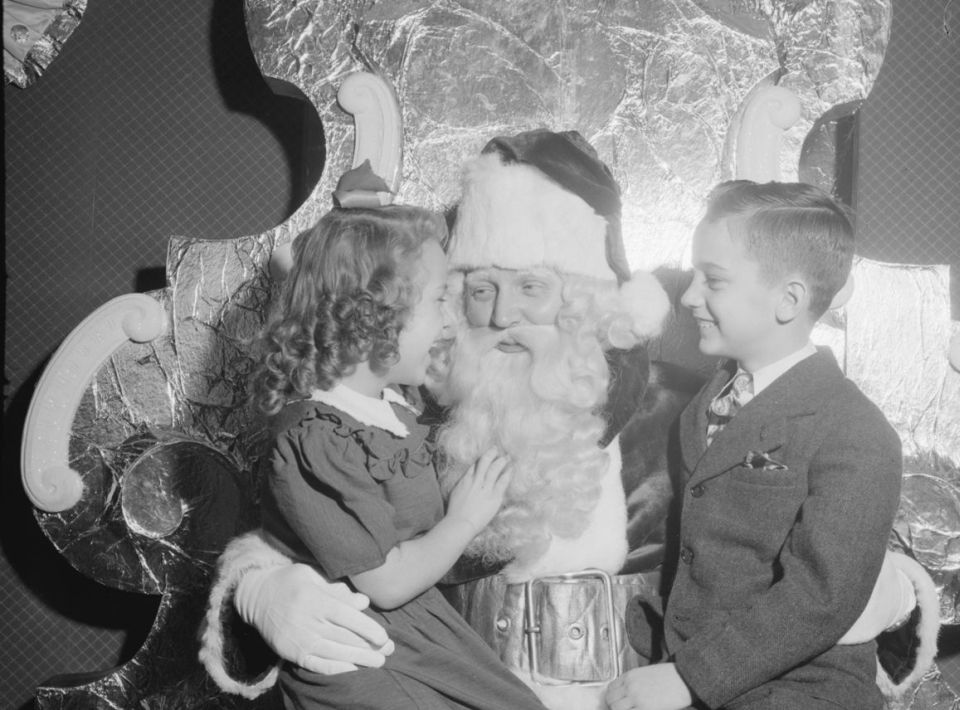There comes a time in every Santa-believer’s life when that believing hits a snag. Often the seeds of doubt are planted by way of schoolyard bullies, or dream-shattering friends, or one’s own late night sneak from a bedroom to catch a parent in the act. At some point geography always gets in the way (“That’s a lot of ground to cover!”), or zoology (“Reindeer can’t fly!”), or ethics (“What kind of labor laws protect those elves anyway?”).
At some point, to be frank, it’s simply easier not to believe.
Yet when faced with my own “Does-he-or-doesn’t-he?” dilemma, I was given a momentary reprieve from the truth. Though eight-year-old me had suffered the irreversible effects of watching The Simpsons Christmas special—including Bart Simpson’s claim to his rotund father that “there’s only one fat guy who brings us presents and his name ain’t Santa”—I was nevertheless certain that the fat guy was named Santa. While I understood there was much evidence to the contrary, I rebuffed all Santa-doubters with a single, inarguable line: “Haven’t you ever heard of Christmas magic?”
My shaky case was buoyed a few weeks later when I waltzed past a television to catch a few minutes of what appeared to be a news program featuring “real footage” of Santa’s workshop in the North Pole.
Today, I can find no record of this show, but if memory serves (and I doubt it does) it was hosted by an Ed-Bradley-type—some reputable journalist whose face I’d come to recognize when glancing up from my Legos to glimpse the nightly news. For me, the footage (complete with hazy, snow blown colored lights captured by way of helicopter) was proof that Santa was—as I always suspected—just another law-abiding (well, except for the B&E) tax-paying citizen like the rest of us. The only differences: he lived forever, descended chimneys like a seasoned contortionist, and ignored all aviation regulations.
As the years wore on, my case became shakier still. Despite the vast photographic evidence of his existence (who doesn’t have a picture with Santa?), it soon became clear that I was the last in the schoolyard still invoking “Christmas magic” as a defense. Since my classmates couldn’t get through to me with words they tried snowballs, flinging them toward my face and suggesting where I might shove my Christmas magic.
Well, it wasn’t quite as traumatic as all that.
Though for some, learning the truth about Santa is indeed traumatic, so much so that a handful of scholars have researched the conditions under which a parent might best break the news. WebMD notes that the key is in figuring out “how to convert the belief in Santa into other expressions of the holiday spirits,” though other sites offer a bit more “practical” advice, including the assurance that parents should simply relax and remain mum—sooner or later somebody’s spoilsport kid will break the news on your behalf.
This may be true, but thankfully, the spoilsports’ argument rarely sticks when the victim is below the age of five. According to University of Texas psychologist Jacqueline Woolley’s 2009 study, five is the peak age for believing in Santa. Soon after, however, this belief begins to decline, leaving parents with a difficult question:
How many lies are we willing to tell to keep our children from the truth?
While I have much respect for those intensely-committed parents who take to their shovels to hurl reindeer poop on their roofs as “proof” of Santa’s having been there, I’ll admit that I’m not ready to go to those lengths. For me, Christmas magic becomes a little less magical when preserving it requires such orchestration. However, for those who enjoy orchestration, might I point you to the Official North Pole Mail’s Evidence Kit, whose contents includes “glasses, torn fabric, a coat button, a jingle bell, toy list, snowy footprints, and even reindeer tracks!” all at the low, low price of $19.99. It’s hard for me to imagine who buys such a kit, though I suppose it appeals most to parents who want their kids to believe that Santa lost a battle with the family schnauzer.
Since we lack both schnauzer and evidence kit, my wife and I try to keep Christmas magic alive by other means. To that end, over Thanksgiving break we corralled our children back to our hometown so that they could enjoy what we always had—the annual Santa lighting. There, in the crowded streets of Fort Wayne, Indiana, a crowd 10,000 strong cheered mightily as 24,000 lights burst to life, reawakening the grand display featuring Santa and reindeer aglow on a building downtown.
 In the moments prior to the lighting, my three-year-old son ran into a middle-aged Santa wandering the streets of Fort Wayne. Henry tugged on the fringe of that man’s Santa suit, and the man inside turned around.
In the moments prior to the lighting, my three-year-old son ran into a middle-aged Santa wandering the streets of Fort Wayne. Henry tugged on the fringe of that man’s Santa suit, and the man inside turned around.
“Hi, Santa!” Henry called.
The man—as if forgetting his attire—appeared puzzled by the encounter.
“Hi Santa,” I repeated, shooting him the eyes.
“Oh yeah, hey!” the man said. “Ho, ho. How’s it going? Or … Merry Christmas.”
Henry took Santa’s greeting as an invitation to reiterate the entirety of his Christmas list, and thankfully, the man—who remembered the responsibilities that came with the suit—had the good sense to play along.
Once Henry was through—once we’d released that man back into the night—my son held my hand and skipped us closer to the lights.
“Dad,” he whispered, his eyes as wide as sugarplums. “I just saw Santa!”
“I know,” I said, refusing his gaze. “I just saw him, too.”




